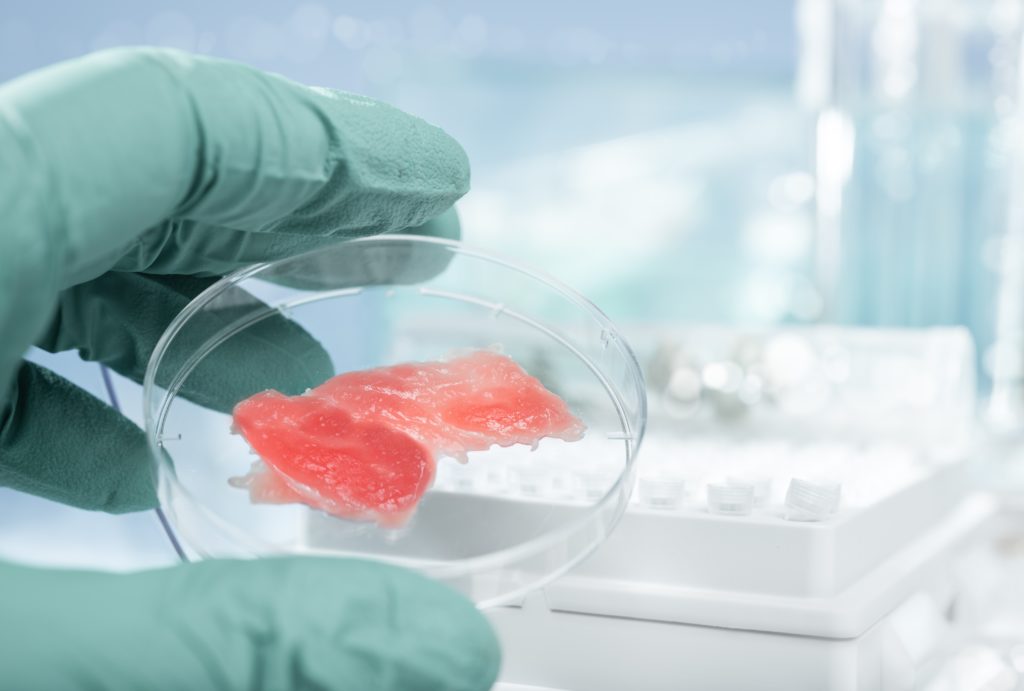
The biotechnology industry has been powering through barriers standing between the lab and the dinner plate as cultured meat advances toward the market. Challenges like scaling up the technology and getting products to the market are significant, but future food demands are an even bigger obstacle. Earth’s population is projected to reach 10 billion people by 2050. Our current agricultural practices will not be able to meet the food demands. Therefore, we need to find alternative ways to produce food–like “growing” it in the lab.
Cellular agriculture is the generation of products from cells in a lab or industrial setting rather than from whole animals. At a base level, this process for cultivating meat is similar to regular cell culture in any research lab. However, scaling up cultured meat comes with a handful of accompanying problems and obstacles.
The Selection Step
Selecting the right cells is important. Some labs start with stem cells that can differentiate into either muscle or fat cells in vitro. Others grow muscle cells derived directly from animals. Likewise, choosing the right cell line is critical. This choice determines the product’s taste and technical parameters like time, temperature, and nutrients needed to produce a 3D product.
One major obstacle that researchers face during the selection process is making sure their cells can grow continuously. In order to make cultured meat sustainable, a cell line must grow and maintain particular features, including size and shape, indefinitely for researchers to avoid repeatedly starting over. Some cell lines have this ability, but others are more problematic.
A UK-based cultured meat biotechnology company, HigherSteaks, seeks to address this issue by using induced pluripotent stem cells (iPSCs). These cells can divide indefinitely, have huge growth potential, and can become either muscle or fat after being nudged with growth factors and molecular signals. Additionally, iPSCs allow researchers to produce multiple tissue types from a single cell line.
Culture Costs
Scaling up cultured meat comes with another accompanying problem: expense. When you add up the total expense of a cell line including culture ingredients, time, and supplies, the average cost is about five hundred dollars per gram.
One of the most expensive components of culturing cells in the lab is growth media. The growth media typically contains nutrients, vitamins, minerals, proteins, and other growth factors. Fetal bovine serum is the source of many components in traditional cell culture media. However, it comes with a hefty price of up to eight hundred dollars per liter. Fetal bovine serum also comes with other issues including variability and ethical controversy about how it is sourced. Even though there are serum-free options to avoid these issues, most cells still won’t grow as quickly as those cultured with serum. Serum-free options lower nutrient, vitamin, and mineral levels which bumps up cultured meat costs. The longer it takes for cell division, the longer the process, and the more money it costs. Ultimately, this reinforces the importance of choosing cells carefully.
Public Perception
There are many views towards cultured meat, and public perception can have a huge impact on the success of these products. Many people hear about cultured meat for the first time and feel unsettled by the idea. Christopher Bryant, PhD in Psychology at the University of Bath, studied consumer acceptance of cultured meat and held focus groups to address this issue. The study showed that the more time people spent with the concept of cultured meat and learned about its benefits, the more comfortable they felt. Bryant recommends cultivated meat companies highlight the full range of benefits when communicating to the public. This includes more obvious benefits like needing to kill fewer animals and less obvious benefits like avoiding antibiotics and lowering the risk of common foodborne diseases.
Conclusion
Although there are obstacles to overcome, the benefits of scaling up cultured meat are well worth the reward. The industry isn’t going to fulfill global food needs any time soon. However, Earth’s ever-growing population will certainly need new approaches–like cultured meat—to meet food needs. Cultured meat can provide a healthy, safe, effective, tasty, and sustainable solution that doesn’t take away from existing fisheries, aquaculture, or farmers.
Related Posts
Riley Bell
Latest posts by Riley Bell (see all)
- Celebrating Our 2023 Promega In Action Awardees - April 18, 2024
- Celebrating 10 Years of Innovation: Introducing the CSCB-Promega Innovation Fund - March 28, 2024
- More Than a Scientist: Paraj Mandrekar’s Career & Contributions to Tabletop Roleplaying Games - January 30, 2024
